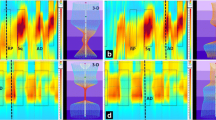Abstract
Background and aims
A subgroup of constipated patients complain of absent or diminished sense of wanting to defecate, suggesting that one of the causes of constipation is impaired rectal sensation. Electrical stimulation therapy (EST) has recently been used to treat patients with urinary and/or fecal incontinence. This study evaluated the efficacy of EST in constipated patients, especially those with impaired rectal sensation.
Patients and methods
Of the 130 patients with functional constipation as defined by Rome II criteria, 22 patients who had impaired rectal sensation (rectal desire threshold volume ≥ 90 ml) on an anorectal manometry were selected. We treated 12 with EST and 10 with biofeedback therapy (BFT) according to a randomized order.
Results
Overall symptoms of patients significantly improved after each therapy in both groups. Interestingly, frequency of sense of wanting to defecate improved only after EST. On objective findings there was significant improvement in anal residual pressures on attempted defecation only after BFT solely. On the other hand, rectal sensory threshold volumes for desire and urge to defecate and maximal tolerated volume improved significantly only in the EST group.
Conclusion
Our findings show that the efficacy of EST can be comparable to BFT in a subgroup of constipated patients, especially those with impaired rectal sensation. EST might be considered as an adjunctive therapeutic modality for the management of functional constipation with impaired rectal sensation.



Similar content being viewed by others
References
Heymen S, Jones KR, Ringel Y, Scarlett Y, Whitehead WE (2001) Biofeedback treatment of fecal incontinence: a critical review. Dig Dis Sci 44:728–736
Enck P (1993) Biofeedback training in disordered defecation. A critical review. Dig Dis Sci 38:1953–1960
Bassotti G, Whitehead WE (1994) Biofeedback as a treatment approach to gastrointestinal tract disorders. Am J Gastroenterol 89:158–164
Rao SS, Welcher KD, Pelsang RE (1997) Effects of biofeedback therapy on anorectal function in obstructive defecation. Dig Dis Sci 42:2197–2205
Chiotakakou-Faliakou E, Kamm MA, Roy AJ, Storrie JB, Turner IC (1998) Biofeedback provides long-term benefit for patients with intractable, slow and normal transit constipation. Gut 42:517–521
Papachrysostomou M, Smith AN (1994) Effects of biofeedback on obstructive defecation-reconditioning of the defecation reflex? Gut 35:252–256
Appell RA (1998) Electrical stimulation for the treatment of urinary incontinence. Urology 51 [Suppl 2A]:24–26
Janknegt RA, Hassouna MM, Siegel SW, Schmidt RA, Gajewski JB, Rivas DA, Elhilali MM, Milam DC, van Kerrebroeck PE, Dijkema HE, Lycklama a Nyeholt AA, Fall M, Jonas U, Catanzaro F, Fowler CJ, Oleson KA (2001) Long-term effectiveness of sacral nerve stimulation for refractory urge incontinence. Eur Urol 39:101–106
Leroi AM, Michot F, Grise P, Denis P (2001) Effect of sacral nerve stimulation in patients with fecal and urinary incontinence. Dis Colon Rectum 44:779–789
Rosen HR, Urbarz C, Holzer B, Novi G, Schiessel R (2001) Sacral nerve stimulation as a treatment for fecal incontinence. Gastroenterology 121:536–541
Vaizey CJ, Kamm MA, Turner IC, Nicholls RJ, Woloszko J (1999) Effects of short term sacral nerve stimulation on anal and rectal function in patients with anal incontinence. Gut 44:407–412
Locke GR III, Pemberton JH, Phillips SF (2000) AGA medical position statement: guidelines on constipation. Gastroenterology 119:1761–1766
Wester C, Brubaker L (1998) Normal pelvic floor physiology. Obstet Gynecol Clin North Am 25:707–722
Read NW, Timms JM, Barfield LJ, Donnelly TC, Bannister JJ (1986) Impairment of defecation in young women with severe constipation. Gastroenterology 90:53–60
Kamm MA, Lennard-Jones JE (1990) Rectal mucosal electrosensory testing-evidence for a rectal sensory neuropathy in idiopathic constipation. Dis Colon Rectum 33:419–423
Baldi F, Ferrarini F, Corinaldesi R, Balestra R, Cassan M, Fenati GP, Barbara L (1982) Function of the internal anal sphincter and rectal sensitivity in idiopathic constipation. Digestion 24:14–22
Mollen RM, Salvioli B, Camilleri M, Burton D, Kost LJ, Phillips SF, Pemberton JH (1999) The effects of biofeedback on rectal sensation and distal colonic motility in patients with disorders of rectal evacuation: evidence of an inhibitory rectocolonic reflex in humans? Am J Gastroenterol 94:751–756
Rao SS, Welcher KD, Leistikow JS (1998) Obstructive defecation: a failure of rectoanal coordination. Am J Gastroenterol 93:1042–1050
Peticca L, Pescatori M (2002) Outlet obstruction due to anismus and rectal hyposensation: effect of biofeedback training. Colorectal Dis 4:67
Binnie NR, Smith AN, Creasey GH, Edmond P (1991) Constipation associated with chronic spinal cord injury: the effect of pelvic parasympathetic stimulation by the Brindley stimulator. Paraplegia 29:463–469
Acknowledgements
We are grateful to Prof. Moo-Song Lee, Department of Preventive Medicine, University of Ulsan College of Medicine, for his advice regarding statistical analysis. This research was presented in part as an oral presentation at the annual meeting of the American Gastroenterological Association, San Francisco, Calif., USA, 19–22 May 2002 (Gastroenterology 2002, 122:A83).
Author information
Authors and Affiliations
Corresponding author
Rights and permissions
About this article
Cite this article
Chang, HS., Myung, SJ., Yang, SK. et al. Effect of electrical stimulation in constipated patients with impaired rectal sensation. Int J Colorectal Dis 18, 433–438 (2003). https://doi.org/10.1007/s00384-003-0483-2
Accepted:
Published:
Issue Date:
DOI: https://doi.org/10.1007/s00384-003-0483-2




